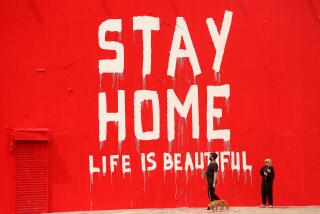California is starting to reopen. But don’t party like it’s 2019 yet

- Share via
Pat yourself on the back, Californians. Two terrible months of quarantining at home, staying six feet from other people, washing your hands raw, avoiding social gatherings and wearing face coverings outside (sometimes, at least) have paid off.
Coronavirus infections and COVID-19 deaths have been kept in check in the most populous state. Better yet, hospitalizations for people sickened by COVID-19 appear to have started going down from last week’s peak.
California’s current totals — 54,937 confirmed cases of COVID-19 and 2,254 deaths — may sound bad, but some public health experts had expected things to be much, much worse at this point. Instead, hospitals haven’t been overrun with sick people. Bodies weren’t stacked up in trucks. And now, after weeks of furious efforts to increase capacity, testing is up to 30,000 people a day statewide. The state has 24 million medical-grade face masks for healthcare providers. More than 10,000 ventilators are sitting idle, and there are 2,072 empty hospital beds.
These are more than just encouraging statistics. Together they mark an important inflection point for the state. California finally begins to reopen this week, albeit slowly and carefully. And it’s vital that we not move faster than it’s safe to go.
Gov. Gavin Newsom announced on Monday that conditions have been met for the state to move into the second of four stages he had outlined for responding to the pandemic. (The first stage was shutting things down.) This means that as soon as Friday, many retail stores and manufacturing sites that the government had labeled nonessential in the first stage can start to reopen to customers, albeit without reopening their doors to them. Instead, they’ll have to limit their interactions to curbside pickup. Later this month, offices may be allowed to open as well, provided they have configured workspaces to curb transmission of the virus.
This is a moment to celebrate, to be sure. But in a socially distanced way. The worst thing would be for this news to lull anyone into thinking COVID-19 is on the run, and it’s time to party like it’s 2019. The pandemic is still raging globally, and hundreds of Americans are still dying every day. Although the Food and Drug Administration’s approval of the experimental drug remdesivir raises hopes for a new treatment for COVID-19 patients, there’s only a limited supply of the medication. It will be months before there are enough doses for everyone who needs it, and remdesivir may not be the answer for patients with highly advanced cases. Meanwhile, a vaccine is still a year, or even years, away, assuming it’s even possible to make a safe and effective one.
For many places, the worst is yet to come. The Centers for Disease Control and Prevention now projects that deaths from COVID-19 in the United States could more than double by June to 3,000 a day, due in large part to premature lifting of social distancing rules in other states. If that happens here, the governor said, we will have to return to more restrictions.
Nobody wants to go back, which makes it imperative that Californians continue observing social distancing and protective measures, such as wearing face coverings in public places and not gathering in large numbers. We know it works, and it’s the only way to reach the important next stage, when most of us will be cleared to go back to work, assuming there’s a job to go to.
Newsom also said Monday that he would be allowing some regions, such as rural counties that have seen relatively few cases of COVID-19, to lift pandemic restrictions more quickly — so long as they can demonstrate that they’re adhering to the guidelines set by the state’s public health officers. Presumably, this is in reaction to the rebellions in recent days in enclaves such as Modoc County, which defied the state’s stay-at-home order by allowing businesses to reopen this week if they took certain safety measures.
Modoc is one of four California counties that has not logged a single coronavirus case, and it makes sense to allow all of them to restart their economies at a faster pace, though with restrictions on large group gatherings and other appropriate precautions. The pandemic has largely been a problem for urban areas, and cities such as Los Angeles must continue to observe pandemic restrictions for the moment.
So, here’s to the first bit of good news in what seems like an endless spring of despair. Let’s do what it takes to make sure it’s not the last one.
More to Read
A cure for the common opinion
Get thought-provoking perspectives with our weekly newsletter.
You may occasionally receive promotional content from the Los Angeles Times.









